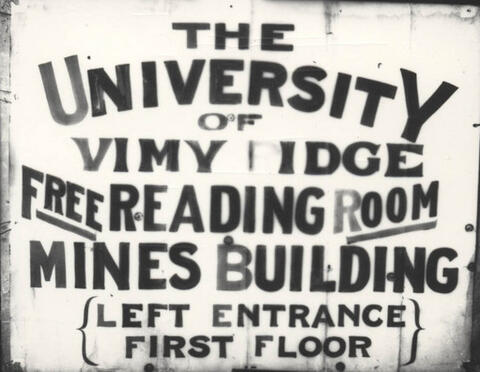
Title and statement of responsibility area
Title proper
University of Vimy Ridge Sign
General material designation
- Graphic material
Parallel title
Other title information
Title statements of responsibility
Title notes
Level of description
Item
Reference code
Edition area
Edition statement
Edition statement of responsibility
Class of material specific details area
Statement of scale (cartographic)
Statement of projection (cartographic)
Statement of coordinates (cartographic)
Statement of scale (architectural)
Issuing jurisdiction and denomination (philatelic)
Dates of creation area
Date(s)
-
[1916-1918] (Creation)
- Place
- France
Physical description area
Physical description
1 photograph : b&w ; 17.5 cm x 12.5 cm
1 negative : b&w ; 10.5 cm x 8 cm
Publisher's series area
Title proper of publisher's series
Parallel titles of publisher's series
Other title information of publisher's series
Statement of responsibility relating to publisher's series
Numbering within publisher's series
Note on publisher's series
Archival description area
Name of creator
Custodial history
Scope and content
University of Vimy Ridge signage.
Bio/Historical Note: Khaki University (initially Khaki College or University of Vimy Ridge) was a Canadian overseas educational institution set up and managed by the general staff of the Canadian Expeditionary Force (CEF) in Britain from 1917-1919 during the First World War. The system, named for the khaki-coloured uniforms of the CEF, was set up by the efforts of Dr. Edmund Henry Oliver, Professor of History and Economics, University of Saskatchewan, and others and was supported by the Young Men's Christian Association (YMCA). The University, with makeshift colleges mainly in central England, was intended to be “a school of efficiency and citizenship, a sort of combination of an Agricultural High School and a Technical School.” Courses were offered in Agriculture, Business Efficiency, Elementary Practical Science, and Citizenship. Classes were scheduled so that battalions could attend during their rest periods. Certificates given were accepted by Canadian universities. An important part of the University’s services was a network of thirty libraries that served more than 50,000 soldiers. Operations were suspended in April 1918 because of the massive German offensive. The war was over by November and Oliver returned to Canada. The term was used again for Canadian educational programs for veterans from 1945-1946 after the Second World War.
Notes area
Physical condition
Immediate source of acquisition
Arrangement
Language of material
Script of material
Location of originals
Availability of other formats
Restrictions on access
Terms governing use, reproduction, and publication
Copyright: Public Domain
Finding aids
Associated materials
Accruals
Location note
vol.27b/neg.vol.4
Alternative identifier(s)
Standard number area
Standard number
Access points
Subject access points
Place access points
Name access points
- University of Vimy Ridge (Subject)
- Khaki University (Subject)

